Al_Fe_Zr三元系中金属间化合物的形成焓计算
- 格式:pdf
- 大小:163.62 KB
- 文档页数:5
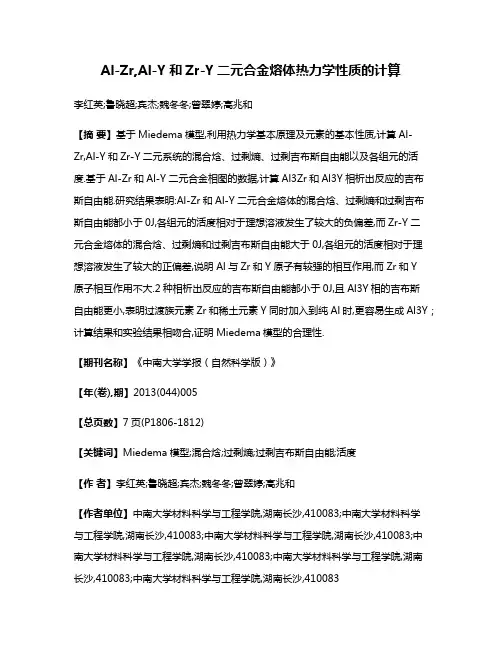
Al-Zr,Al-Y和Zr-Y二元合金熔体热力学性质的计算李红英;鲁晓超;宾杰;魏冬冬;曾翠婷;高兆和【摘要】基于Miedema模型,利用热力学基本原理及元素的基本性质,计算Al-Zr,Al-Y和Zr-Y二元系统的混合焓、过剩熵、过剩吉布斯自由能以及各组元的活度.基于Al-Zr和Al-Y二元合金相图的数据,计算Al3Zr和Al3Y相析出反应的吉布斯自由能.研究结果表明:Al-Zr和Al-Y二元合金熔体的混合焓、过剩熵和过剩吉布斯自由能都小于0J,各组元的活度相对于理想溶液发生了较大的负偏差,而Zr-Y二元合金熔体的混合焓、过剩熵和过剩吉布斯自由能大于0J,各组元的活度相对于理想溶液发生了较大的正偏差,说明Al与Zr和Y原子有较强的相互作用,而Zr和Y原子相互作用不大.2种相析出反应的吉布斯自由能都小于0J,且Al3Y相的吉布斯自由能更小,表明过渡族元素Zr和稀土元素Y同时加入到纯Al时,更容易生成Al3Y;计算结果和实验结果相吻合,证明Miedema模型的合理性.【期刊名称】《中南大学学报(自然科学版)》【年(卷),期】2013(044)005【总页数】7页(P1806-1812)【关键词】Miedema模型;混合焓;过剩熵;过剩吉布斯自由能;活度【作者】李红英;鲁晓超;宾杰;魏冬冬;曾翠婷;高兆和【作者单位】中南大学材料科学与工程学院,湖南长沙,410083;中南大学材料科学与工程学院,湖南长沙,410083;中南大学材料科学与工程学院,湖南长沙,410083;中南大学材料科学与工程学院,湖南长沙,410083;中南大学材料科学与工程学院,湖南长沙,410083;中南大学材料科学与工程学院,湖南长沙,410083【正文语种】中文【中图分类】TG146.2铝及铝合金具有比强度高、塑韧性较好和可加工性能好等优点,广泛应用于建筑、航天航空、汽车和电力传输等众多领域。
随着科学技术的不断发展,对铝及铝合金的性能提出了更高的要求,必须开发新型高性能铝合金、提升传统铝合金的综合性能来满足应用需求[1]。

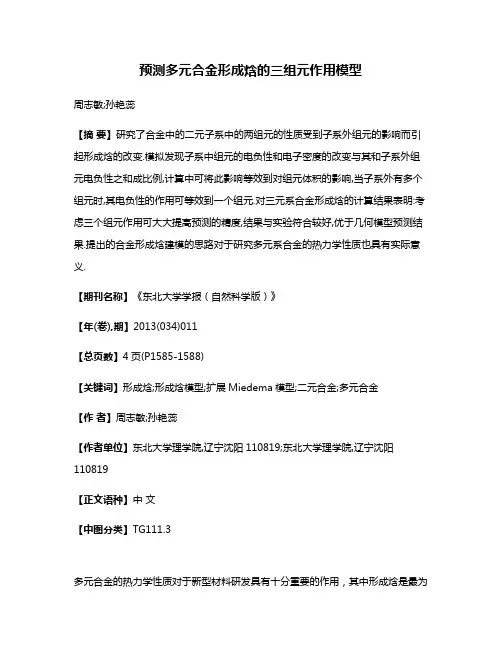
预测多元合金形成焓的三组元作用模型周志敏;孙艳蕊【摘要】研究了合金中的二元子系中的两组元的性质受到子系外组元的影响而引起形成焓的改变.模拟发现子系中组元的电负性和电子密度的改变与其和子系外组元电负性之和成比例,计算中可将此影响等效到对组元体积的影响,当子系外有多个组元时,其电负性的作用可等效到一个组元.对三元系合金形成焓的计算结果表明:考虑三个组元作用可大大提高预测的精度,结果与实验符合较好,优于几何模型预测结果.提出的合金形成焓建模的思路对于研究多元系合金的热力学性质也具有实际意义.【期刊名称】《东北大学学报(自然科学版)》【年(卷),期】2013(034)011【总页数】4页(P1585-1588)【关键词】形成焓;形成焓模型;扩展Miedema模型;二元合金;多元合金【作者】周志敏;孙艳蕊【作者单位】东北大学理学院,辽宁沈阳110819;东北大学理学院,辽宁沈阳110819【正文语种】中文【中图分类】TG111.3多元合金的热力学性质对于新型材料研发具有十分重要的作用,其中形成焓是最为基础和重要的,其理论估算受到材料研究者的普遍关注.目前,预测多元合金的形成焓可以采用量子或统计理论建立热力学模型来计算[1-2],也可以根据二元系数据用几何模型来计算[3-5].前者基础理论概念清晰,但计算量较大;后者使用简便,但预测精度还不够,尤其不能满足计算材料科学发展的需要.在合金热力学性质预测中,一类值得关注的估算方法是在材料与冶金科学领域中被人们广泛采用的计算二元合金形成焓的半经验模型——Miedema模型[6-7],其适应性较好,在绝大多数情况下都能给出较好的变化趋势,但其计算精度还不够高.为此,一些学者尝试从提高计算精度和扩大适应范围两方面进行改进[8-11].在由二元系向三元或多元系扩展的建模过程中,体系被看做是由不同权重的二元子系所构成,在一定程度上具有几何模型的特点,对体系多组元间的交互作用的贡献则缺乏考虑.本文利用Miedema模型的优点,考虑合金中多组元间的物理作用,从理论上研究任一组元受到其他组元的综合影响,提出了三组元作用模型.通过考虑此作用对合金形成焓的贡献,提高了多元合金形成焓的计算精度.1 三组元作用模型为方便起见,以三元系为例分析三组元作用对合金形成焓的影响,记组元1,2和3构成的体系为三元系1-2-3,其中由组元1和2构成子系1-2,同理有子系2-3和子系3-1.假设二元系1-2,2-3和3-1的形成焓已知,则三元系1-2-3的形成焓为考虑组元间综合作用的各子系的贡献.以子系1-2为例,仅考虑两组元间作用的贡献ΔH12为(1)其中w12表示子系1-2的权重.表示组元1和2保持与三元系中的摩尔分数之比相等时的形成焓.同理确定和子系1-2中组元1和2的电负性差和电子密度差等物理量受到系统中组元3的影响作用,使ΔH12的值变为ΔH12,3.因此,三元系的形成焓应为ΔH123=ΔH12,3+ΔH23,1+ΔH31,2.(2)可按照Miedema模型表示为(3)其中ΔHlin2是组元1溶解在2中的稀溶液的形成焓,X1为组元1的摩尔分数,表示二元系中组元1被组元2的原子包围的程度.对于三元系,其对应的形成焓可记为(4)式中:x1为三元系中组元1的摩尔分数;表示三元系中组元1被组元2的原子包围的程度.由式(1)、式(3)和式(4)得(5)对于简单无序情况,其中V1和V2分别为组元1和2在合金中的体积.在三元系中有则式(5)可写为(6)式(6)表示了三元系中存在组元3时子系1-2对形成焓的贡献权重.虽然w12由Miedema模型推出,但由于它采用二元变换到三元系的权重比例来表示,避免了直接计算带来的误差.系统中任一组元对其他组元的体积、电负性差、电子密度差有影响.将组元i的变化记为和则(7)可由Miedema模型计算,将其中的体积、电负性差、电子密度差用变化后的值代替得ΔH12,3,将所得等式与ΔH12比较,整理并略去变化高阶量.注意到此处因采用比值表达形式,可将修正参量r=R/P的值取作0,得(8)式中:及其他参数具有与Miedema模型中相同的意义.同理可以确定ΔH23,1和ΔH31,2.2 多组元作用时的物理量估算原子体积的改变将引起的电子密度和电负性的改变,同时合金化的电负性之和又反过来影响各个量的变化.1) 电子密度变化.设组元i的原子周围的电子数为N,其密度可表示为(9)则(10)从而,由式(9)和式(10)可得组元i由于原子体积变化引起的电子密度改变为(11)2) 电负性变化.根据Miedema模型中对电负性的定义(12)得(13)式中Zi为组元i的价电子数,由式(12)两端对求偏导,并考虑式(13)可得(14)(15)3) 体积变化.与Miedema模型中对组元i的表面积的计算方法相似,对于多元系,有(16)组元k的存在引起组元i的变化为(17)4) 三组元电负性作用模型.电子密度变化不仅与体积变化有关,而且还与电负性有关.这是因为电负性是原子吸引电子能力的一种相对标度,电负性愈大,吸引电子的倾向愈大;反之,吸引电子的倾向愈小.因此,原组元i电子密度和电负性将因组元k的存在而发生变化,并且应该与i和k的电负性之和成正比.从式(11)和式(15)可见,这种变化可等效为体积的改变,即将式(17)修正如下.(18)其中,右侧的符号表示电负性之和对体积改变的方向.在很多情况下,系统中的组元数较多,此时式(18)中的应该用子系i-j之外的所有其他组元电负性的均值来代替,即(19)3 预测结果与讨论考虑系统中三组元作用对电负性、电子密度差等的影响,使合金形成焓的预测精度改善.利用本文模型对几组三元系合金的形成焓进行计算,并与两个具有代表性的几何模型以及实验数据进行比较.为了避免二元合金形成焓数据带来计算误差,这里采用二元合金形成焓的实验数据作为三元系计算的依据,实验数据取自参考文献[12],预测结果如图1所示.显然,本文模型的预测结果从总体上看更接近实验值. 从建模过程可以看出本文模型预测结果较好的原因.几何模型在计算系统的形成焓时,先根据系统中各组元的摩尔分数确定各二元子系代表点的含量,以此计算该子系的形成焓和权重,从而计算出其贡献,选点方法的不同对计算结果有一定影响.Toop模型根据各个组元的性质先确定一个非对称组元,并保持其在二元子系中的摩尔分数与在多元系中相同来进行计算;Chou模型则引入由二元子系的自由能偏差程度表示的偏差函数,以此构造相似系数,并进行二元子系的选点和计算.本文则从影响形成焓的基本参量入手,根据多元系形成过程中各组元的电子密度、电负性和体积的变化确定二元子系的贡献及权重.可见,几何模型在确定二元子系的贡献时是依据形成焓的具体数值,而本文模型则是依据影响形成焓的基本参量的变化.因此,本文模型是依据内在因素变化建立的物理模型,消除了几何模型在确定选点方面的人为性.本文模型采用Miedema定义的一些物理参量,考虑了系统中任一组元对其他组元周围电子的吸引作用及其对电负性和体积变化的影响,使预测结果更加准确;另外,二元系的形成焓通常为已知,因此在推导过程中通过采用与已知二元子系的形成焓数据的比值关系,降低了直接计算带来的误差,这也是计算时不考虑r影响的原因.图1 三元合金形成焓计算结果及实验结果比较Fig.1 Comparison of calculated formation enthalpies of ternary alloys with the experimental results点实线:本文模型;实线:Chou模型[4];虚线:Toop模型[3,8];点:实验值[12].4 结论1) 多元系合金中任一组元对其他组元的电子密度、电负性、体积等参量具有一定影响,三组元作用是影响多元系形成焓计算精度的重要因素.2) 三元合金中任一组元的电负性对其他组元的电负性和电子密度的影响与此二组元电负性之和成比例,此作用在计算时可等效到式(18)表示的组元体积的改变;而对于多元系则可等效到式(19)表示的三组元电负性作用模型.参考文献:[1] Daw M S,Baskes M.Embedded atom method:derivation and application to impurities,surfaces,and other defects in metals[J].Physical ReviewB,1984,33(13):6443-6449.[2] Baskes M I.Modified embedded-atom potentials for cubic materials and impurities[J].Physical Review B,1992,46(5):2727-2742.[3] Toop G W.Predicting ternary activities using binary data[J].Transactions of the Metallurgical Society of AIME,1965,233(5):850-855.[4] Chou K C,Wei S K.A new solution model for predicting thermodynamic properties of multi-component system frombinaries[J].Metallurgical and Materials Transations B,1997,28(3):439-445. [5] 周国治.新一代的溶液几何模型及其今后的展望[J].金属学报,1997,33(2):126-132.(Zhou Guo-zhi.New generation solution geometrical model and its further development[J].Acta Metallurgica Sinica,1997,33(2):126-132.)[6] Miedema A R,Chattel P F,Boer F R.Cohesion in alloys-fundamentals of a semi-empirical model[J].Physica B,1980,100:1-28.[7] Miedema A R.Energy effects and charge transfer in metal physics modeling in real space[J].Physica B,1992,182:1-17.[8] Li H Q,Yang Y S,Tong W H,et al.Calculation of Gibbs energy of Zr-Al-Ni,Zr-Al-Cu,Al-Ni-Cu and Zr-Al-Ni-Cu liquid alloys based on quasiregular solution model[J].Journal of Alloys and Compounds,2007,428:185-189. [9] Goncalves A P,Almeida M.Extended Miedema model:predicting the formation enthalpies of intermetallic phases with more than two elements[J].Physica B,1996,228(3-4):289-294.[10]Zhang B W,Jesser W A.Formation energy of ternary alloy systems calculated by an extended Miedema model[J].PhysicaB,2002,315(1/2/3):123-132.[11]Wang W C,Li J H,Yan H F,et al.A thermodynamic model proposed for calculating the standard formation enthalpies of ternary alloysystems[J].Scripta Materialia,2007,56:975-978.[12]Ouyang Y F,Zhong X P,Du Y,et al.Enthalpies of formation for the Al-Cu-Ni-Zr quaternary alloys calculated via a combined approach of geometric model and Miedema theory[J].Journal of Alloys andCompounds,2006,42:175-181.。

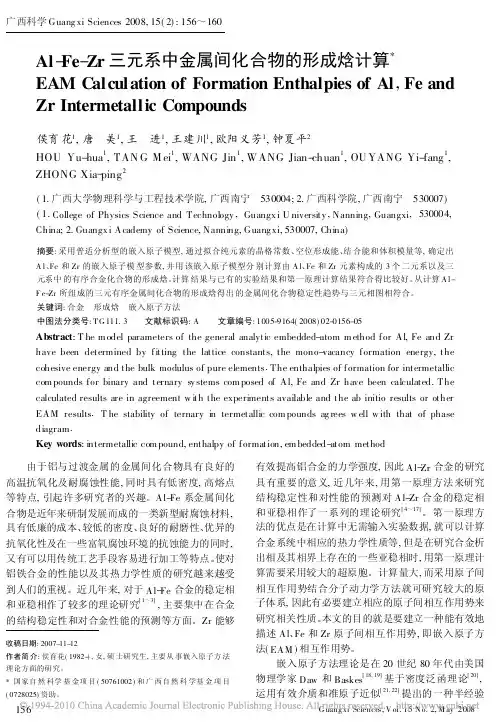

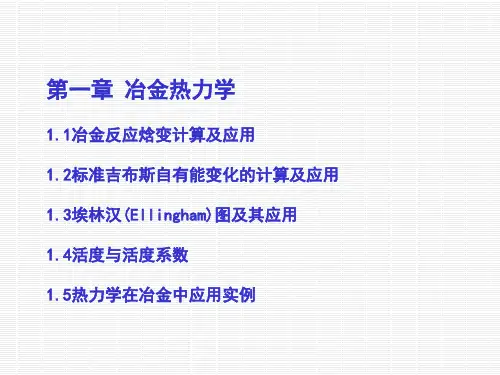
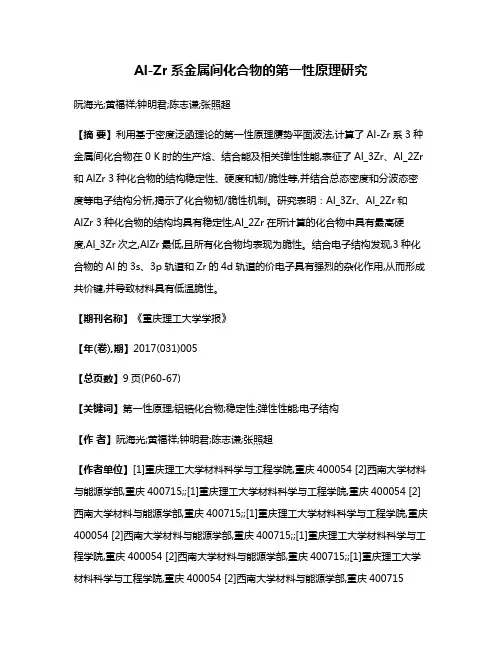
Al-Zr系金属间化合物的第一性原理研究阮海光;黄福祥;钟明君;陈志谦;张照超【摘要】利用基于密度泛函理论的第一性原理赝势平面波法,计算了Al-Zr系3种金属间化合物在0 K时的生产焓、结合能及相关弹性性能,表征了Al_3Zr、Al_2Zr 和AlZr 3种化合物的结构稳定性、硬度和韧/脆性等,并结合总态密度和分波态密度等电子结构分析,揭示了化合物韧/脆性机制。
研究表明:Al_3Zr、Al_2Zr和AlZr 3种化合物的结构均具有稳定性,Al_2Zr在所计算的化合物中具有最高硬度,Al_3Zr次之,AlZr最低,且所有化合物均表现为脆性。
结合电子结构发现,3种化合物的Al的3s、3p轨道和Zr的4d轨道的价电子具有强烈的杂化作用,从而形成共价键,并导致材料具有低温脆性。
【期刊名称】《重庆理工大学学报》【年(卷),期】2017(031)005【总页数】9页(P60-67)【关键词】第一性原理;铝锆化合物;稳定性;弹性性能;电子结构【作者】阮海光;黄福祥;钟明君;陈志谦;张照超【作者单位】[1]重庆理工大学材料科学与工程学院,重庆400054 [2]西南大学材料与能源学部,重庆400715;;[1]重庆理工大学材料科学与工程学院,重庆400054 [2]西南大学材料与能源学部,重庆400715;;[1]重庆理工大学材料科学与工程学院,重庆400054 [2]西南大学材料与能源学部,重庆400715;;[1]重庆理工大学材料科学与工程学院,重庆400054 [2]西南大学材料与能源学部,重庆400715;;[1]重庆理工大学材料科学与工程学院,重庆400054 [2]西南大学材料与能源学部,重庆400715【正文语种】中文【中图分类】O482铝合金由于具有优良的综合性能,如比强度和比刚度高、良好的导电性能、耐腐蚀性好,易回收等,目前被广泛用于航天、汽车、电子、生物医学、建筑等领域,并已发展成为继钢铁之后使用最广泛的有色金属材料[1-5]。
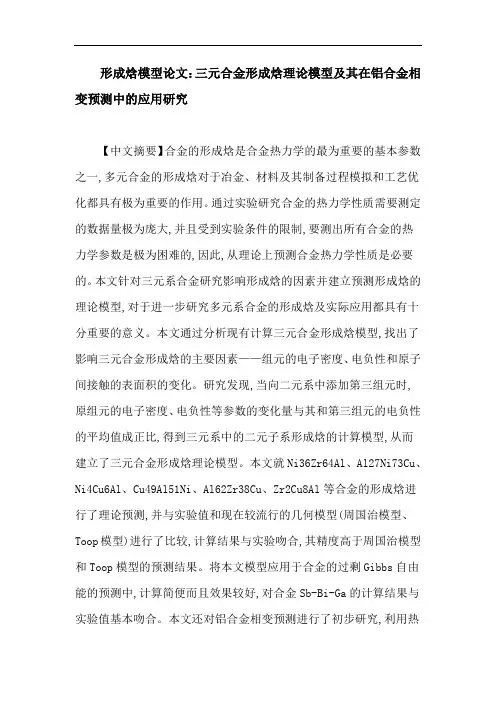
形成焓模型论文:三元合金形成焓理论模型及其在铝合金相变预测中的应用研究【中文摘要】合金的形成焓是合金热力学的最为重要的基本参数之一,多元合金的形成焓对于冶金、材料及其制备过程模拟和工艺优化都具有极为重要的作用。
通过实验研究合金的热力学性质需要测定的数据量极为庞大,并且受到实验条件的限制,要测出所有合金的热力学参数是极为困难的,因此,从理论上预测合金热力学性质是必要的。
本文针对三元系合金研究影响形成焓的因素并建立预测形成焓的理论模型,对于进一步研究多元系合金的形成焓及实际应用都具有十分重要的意义。
本文通过分析现有计算三元合金形成焓模型,找出了影响三元合金形成焓的主要因素——组元的电子密度、电负性和原子间接触的表面积的变化。
研究发现,当向二元系中添加第三组元时,原组元的电子密度、电负性等参数的变化量与其和第三组元的电负性的平均值成正比,得到三元系中的二元子系形成焓的计算模型,从而建立了三元合金形成焓理论模型。
本文就Ni36Zr64Al、Al27Ni73Cu、Ni4Cu6Al、Cu49Al51Ni、Al62Zr38Cu、Zr2Cu8Al等合金的形成焓进行了理论预测,并与实验值和现在较流行的几何模型(周国治模型、Toop模型)进行了比较,计算结果与实验吻合,其精度高于周国治模型和Toop模型的预测结果。
将本文模型应用于合金的过剩Gibbs自由能的预测中,计算简便而且效果较好,对合金Sb-Bi-Ga的计算结果与实验值基本吻合。
本文还对铝合金相变预测进行了初步研究,利用热力学模型来计算合金的相变点,对Al-Si合金的富Al区的计算结果与相图数据吻合较好。
通过本文研究得出电子密度、电负性、原子间接触的表面积等影响合金形成焓的主要参数的变化规律,以此建立的三元合金的形成焓理论模型对于凝固过程跨尺度计算机模拟及合金制备过程工艺参数优化具有实用价值。
【英文摘要】The formation enthalpy is the most important thermodynamic parameters of alloy. The formation enthalpy of multi-alloy plays an important role in metallurgy, materials processing as well as the multiscal simulation of microstructural evolution and properties of alloys in the forming process. It is hard to experimentally measure all of the thermodynamic parameters for all alloys because of the tremendous amount of data as well as the limited experimental conditions. Therefore, it is necessary to theoretically predict thermodynamic properties of alloys. This paper studied the main factors influencing the formation enthalpy of ternary alloy and has established a theoretical model of formation enthalpy for ternary alloy. It is of great significance for the further study of the formation enthalpy for commercial alloy and practical applications.Theoretical analysis shows that the change of the electron density, the electronegativity and the atomic contact surface area has a large influence on theformation enthalpy. It is found that when adding to the binary system a third alloying element, the change of the electron density and electronegativity of the original component is proportional to the average value of electronegativity of said component and the third one. Thus we obtain the contribution of corresponding binary sub-system of the investigated system. Finally the model of formation enthalpy for ternary alloys is established. By using the proposed model, the formation enthalpy of such alloys as Ni64Zr36Cu, Ni36Zr64Cu, Ni36Zr64Al, Al27Ni73Cu, Ni4Cu6Al, Cu49Al51Ni, Al62Zr38Cu, Zr2Cu8Al, etc., is predicted. The calculated results are superior to that of Zhou model and Toop model, and well consistent with the experimental results. The application of the present model to the estimation of the excess Gibbs free energy of alloys is simple and effective. The calculated result for Sb-Bi-Ga alloy is in good agreement with the experimental data. In this paper, a preliminary study was made to calculate thephase-transformation of alloys. The calculated result forAl-Si alloys in Al-rich zone is in agreement with the phase diagram data.The influence of the change of the electron density, electronegativity, atomic surface area of contact affect on the formation enthalpy of alloy is obtained in thisdissertation. The established model for tenary alloys can be used for the multiscale simulation of the materials forming process as well as the optimization of the processing parameters.【关键词】形成焓模型三元合金铝合金【英文关键词】model of formation enthalpy ternary alloy Al alloy【目录】三元合金形成焓理论模型及其在铝合金相变预测中的应用研究【备注】索购全文在线加好友:1.3.9.9.3.8848同时提供论文写作一对一指导和论文发表委托服务摘要5-6Abstract6-7第1章绪论11-25 1.1 半固态合金设计及其制备工艺11-19 1.1.1 半固态成形技术12-14 1.1.2 半固态铝合金14-19 1.1.2.1 改善组织性能的途径17-18 1.1.2.2 半固态铝合金研究18-19 1.2 合金热力学性质的理论研究19-21 1.2.1 合金热力学性质理论研究的意义19 1.2.2 热力学性质理论研究的现状19-21 1.3 半固态合金设计中热力学参数的来源21-22 1.4 本文的研究内容及意义22-25第2章形成焓的计算方法25-45 2.1 物理模型25-36 2.1.1 嵌入原子方法(EAM)25-29 2.1.2 空缺分子实体模型(MEVM)29-31 2.1.3 分子相互作用体积模型(MIVM)31-33 2.1.4 扩展的Miedema模型33-35 2.1.4.1A.P.Goncalves和M.Almeida模型33 2.1.4.2 张邦维模型33-34 2.1.4.3 两步计算模型(ATCM)34-35 2.1.4.4 类似规则溶液模型35 2.1.5 CSA模型35-36 2.2 几何模型36-43 2.2.1 Bonnier模型36-37 2.2.2 Kohler模型37-38 2.2.3 Toop模型38 2.2.4 Colinet和Malakhov模型38-39 2.2.5 Gather模型39 2.2.6 Muggianu模型39 2.2.7 Hillert模型39-40 2.2.8 周国治模型40 2.2.9 王之昌模型40 2.2.10 Zheng Fang模型40-41 2.2.11 周国治新模型41-42 2.2.12 Chen等提出的模型42 2.2.13 欧阳义芳模型42-43 2.3 形成焓计算方法的分析43-45 2.3.1 物理模型分析43 2.3.2 几何模型分析43 2.3.3 建立形成焓理论模型的构想43-45第3章三元合金形成焓理论模型的建立45-63 3.1 影响形成焓的因素分析45-48 3.2 三元合金的形成焓模型48-55 3.2.1 不考虑第三组元的影响49-51 3.2.1.1 两组元合金形成焓的确定50 3.2.1.2 子系权重的确定50-51 3.2.2 考虑第三组元的影响51-55 3.2.2.1 形成焓模型51-52 3.2.2.2 电子密度变化52-53 3.2.2.3 电负性变化53 3.2.2.4 体积变化53 3.2.2.5 电负性对各参量的影响53-55 3.3 模型验证55-63第4章相变预测63-75 4.1 Gibbs自由能模型63-69 4.1.1 纯组元Gibbs自由能的计算方法63-65 4.1.2 合金的过剩Gibbs自由能由能的计算方法65-66 4.1.3 合金过剩Gibbs自由能模型验证66-69 4.2 相变预测69-75 4.2.1 计算原理69-70 4.2.1.1 体系总Gibbs自由能最小法70 4.2.1.2 化学势相等法70 4.2.1.3 做切线法70 4.2.1.4 数学求导法70 4.2.2 计算方法70-71 4.2.3 Al-Si相变预测71-75第5章结论75-77参考文献77-83致谢83。
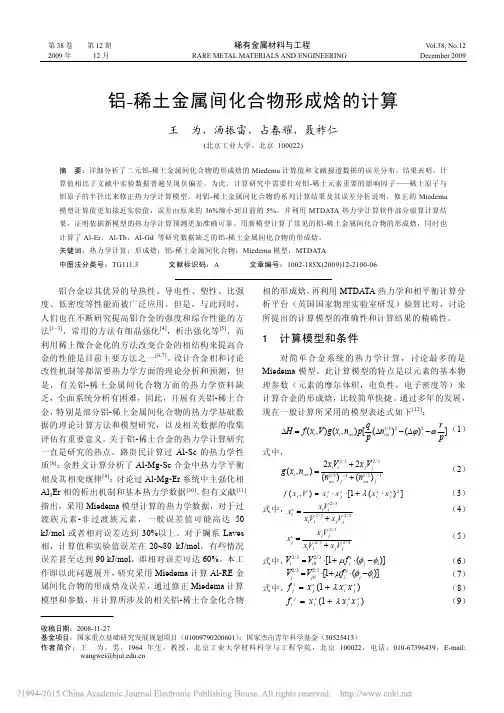
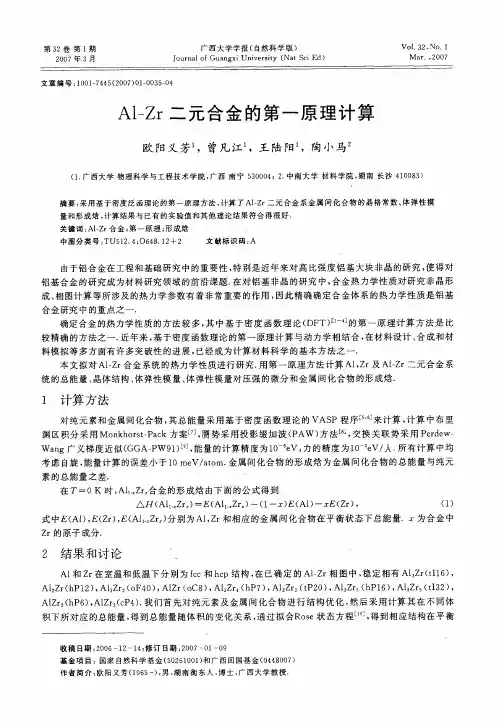
金属间化合物的标准生成焓估算模型
标准生成焓估算模型可用于估算金属间化合物的标准生成焓,即反应的焓变。
它是基于以下几点:
1)金属间化合物的标准生成焓可以用金属原子的标准生成焓和其他化合物的标准生成焓之和来表示;
2)金属原子的标准生成焓可以用金属原子的原子序数和原子量来表示;
3)其他化合物的标准生成焓可以用其他化合物的原子序数和原子量来表示;
4)金属间化合物的标准生成焓可以用金属间化合物的原子序数和原子量来表示。
因此,金属间化合物的标准生成焓可以用以下公式来计算:
ΔH°= ΣnMΔH°f(M) + ΣnXΔH°f(X)
其中,ΔH°f(M)表示金属原子的标准生成焓,ΔH°f(X)表示其他化合物的标准生成焓,nM 和nX分别表示金属原子和其他化合物的原子数。
The calculation of surface energies and formation enthalpies of metallic Mo and W nanocrystalsD. Xie *, M. P. Wang, L. F. Cao, Y. L. JiaSchool of Materials Science and Engineering, Central South University, Changsha 410083, China* Author to whom correspondence should be addressed.Tel.: +86-731-8830264. Fax: +86-731-8876692. E-mail: patriot_csu@AbstractA simple but valid equation for the higher surface energies of metallic nanocrystals is obtained, the formation enthalpies of nanocrystals are calculated by using the equation of surface energies, and the structure variation induced formation enthalpies are also discussed. The calculated surface energy values of Ag and Au nanocrystals are in excellent agreement with the corresponding newest experimental values, and the predicted formation enthalpy values are consonant with the corresponding experimental values of Mo and W nanocrystals.Keywords:Metallic nanocrystals, Surface energy, Formation enthalpySince Kim et al. [1] reported the first experimental data on the formation enthalpies of Mo and W by measuring the oxidation enthalpies of nanocrystals, several authors began to investigate the important thermodynamic parameter theoretically [2-4]. Despite the success, most of the models established in the literatures under different theoretical origins, avoided to discuss the structure variations of nanocrystals which could directly influence the formation enthalpies ( for example, the structure of Mo and W nanocrystals can be changed from BCC structure to FCC structure with crystals size decreasing [1] ), and can not determine the surface induced and structuralinduced formation enthalpies of nanocrystals. Recently, Qi made efforts to present a thermodynamic method to calculate the surface contribution to formation enthalpies of nanocrystals, and tried to calculate the structural induced formation enthalpies indirectly by considering the structure variations of nanocrystals [5], but unfortunately the calculations presented by the author seems wrong which we will discuss later.In this letter, a simple but valid equation for higher surface energies of metallic nanocrystals is obtained to calculate the formation enthalpies of Mo and W nanocrystals, and the formation enthalpy induced by structure variation are also discussed.According to the discussions on the surface and structural effects of nanocrystals by Kim et al. [1], the formation enthalpy of nanocrystal ΔH should be written as followssurf sv H H H ∆=∆+∆ (1)where ΔH surf denotes the formation enthalpy induced by surface, ΔH sv denotes the formation enthalpy induced by structure variation, whose absolute value could also be regarded as the value of solid structure transition energy. ΔH sv =0 when the structure of the nanocrystals has no difference from that of the corresponding bulk.It is know that the surface induced formation enthalpy of a nanocrystal can be written as ΔH surf = S γn , where S is the surface area, γn is the surface energy per unit area at 0 K [6]. Though the γn value of free nanocrystal is supposed to be size and structure independence and equal to the corresponding bulk value by a few of authors[5], there are lots of literatures to confirm both experimentally and theoretically that the value of γn is much higher than that of the corresponding bulk and varies with the changed structure [7-10]. For instance, the size independence surface energies of γn have been experimentally determined by Nanda et al. as 7.2 J/m 2 for free FCC Agnanoparticles [7] and 9.0 J/m 2 for free FCC Au nanoparticles [11] by studying the size dependence evaporation of nanoparticles relating to Kelvin effect in latest 2 years, and it is apparently that the experimental values of nanoparticles are significantly higher than the corresponding bulk values of 1.25 J/m 2 and 1.5 J/m 2 [10] respectively. Based on our previous work in theoretical studying the thermal stability of nanocrystals [4,12-14], the following two equations are obtained by a continuous model [14] and a discontinuous model [4] on the cohesive energy2n n b 13236a E E n Cµγ=− (2) n b b 1323236114E E E n C k µµαπ⎛⎞⎛⎜⎟⎜⎜⎟⎜⎜⎟⎜⎝⎠⎝=−=−⎞⎟⎟⎟⎠ (3) Where E n and E b denote the cohesive energy of nanocrystal and corresponding bulk respectively, α and n denote the surface-to-volume atomic ratio and the atomic number of nanocrystal respectively , a denotes lattice parameter, μ denotes the shape factor which defined as the ratio of surface areas between random shape and cube of nanocrystals in identical volume [4,12,15], k is the ratio between atomic radius and lattice parameter, and C is the atomic number of one structure cell. For FCC, BCCand HCP structures, k and 1/2, C are 4, 2 and 2 respectively [16]. By combining Eq. (2) and Eq. (3), a simplified formula for surface energy of nanocrystal can be givenb n 22E k aγπ= (4) In order to confirm the validity of Eq. (4), the γn values of free FCC Ag and Au nanoparticles are calculated by the above equation, and the results 7.2 J/m 2 for Ag nanoparticles and 9.3 J/m 2 for Au nanoparticles are quite in agreement with the experimental values 7.2 J/m 2 for Ag nanoparticles [7] and 9.0 J/m 2 for Au nanoparticles [11] respectively, which implies that the higher constant of surfaceenergy is an intrinsic property of nanocrystal compared with its bulk value. ( Note that the E b values of Ag and Au are 2.95 eV and 3.81 eV [17], the a values are 4.09 Å and 4.08 Å respectively [17].)When there is no structure variation between nanocrystal and corresponding bulk, the formation enthalpy can be written as0n 0b surf 132326N S N E H H n n C kγµπ∆=∆== (5) Where N 0 denotes the Avogadro constant.It is reported that the thermodynamic parameters of nanocrystals are sensitive to crystals shape [18], and the shapes of Mo and W nanocrystals are reported changing from sphericity to regular polyhedron [1]. Based on the calculations of shape factor in our previous works [12,15], the μ value is regarded ranging between 0.81 (sphericity) and 1.20 (regular tetrahedron). The calculated results from Eq. (5) and the input constants are all listed in Table 1.As shown in Table 1, the calculated surface energies of 21.8 J/m 2 for Mo nanocrystal and 23.5 J/m 2 for W nanocrystal are about 7 times higher than the corresponding bulk of 2.95 J/m 2 [10] and 3.30 J/m 2 [10] respectively. Since there are no experimental values on surface energies of Mo and W nanocrystals till now, and we can not testify the availability of the values directly, the fact that the calculated formation enthalpies of BCC Mo and W nanocrystals are in agreement with corresponding experimental results confirmed the validity of the theoretical surface energy values of Mo and W nanoparticles indirectly. The ignorable deviation between experimental value and our theoretical result of W nanocrystal is regarded to be caused by the rough estimation of n in experiment [1] and the neglect of surface relaxation and surface reconstruction in our calculation. The negative values of structure variation induced formation enthalpies, calculated indirectly in this work,suggest that the FCC structure of Mo and W nanocrystals are more stable than the BCC structure with the crystals size decreasing, which are quite consonant with the experimental observation of others [1,19].The calculated surface induced formation enthalpies in terms of Ref. [5], which supposed the surface energies of free nanocrystal are size and structure independence and equal to the corresponding bulk values, are also listed in the Table 1. It is apparently that the calculated results are only about 15% of the values of the whole formation enthalpies, which directly contradict with the acknowledged conclusion that the differences of thermodynamic parameters between nanocrystals and corresponding bulks are mostly caused by the large specific surface areas [20]. (Note that there are obvious calculating errors in Ref. [5], for the author takes the atomic diameter 0.3099 nm and 0.3117 nm as atomic radius by mistake.)In conclusion, a simple equation for the higher surface energies of nanocrystals is obtained, the calculated results of Ag and Au nanocrystals are in excellent agreement with corresponding experimental values. The formation enthalpies of nanocrystals are calculated by using the theroretical surface energy values 21.8 J/m2 for Mo nanocrystal and 23.5 J/m2 for W nanocrystal, and the predicted values are consonant with the corresponding experimental values of Mo and W nanocrystals. The structure variation induced formation enthalpies are obtained indirectly.AcknowledgementHelpful discussions with Professor Z. P. Jin are gratefully appreciated.This work was supported by the Tenth Five-year Plan of Key Technologies R & D Programme of China (No. 2001BA310A03-1)References[1] H. K. Kim, S. H. Huh, J. W. Jeong, G. H. Lee, Chem. Phys. Lett. 354 (2002) 165.[2] Q. Jiang, J. C. Li, B. Q. Chi, Chem. Phys. Lett. 366 (2002) 551.[3] W. H. Qi, M. P. Wang, G. Y. Xu, Chem. Phys. Lett. 372 (2002) 632.[4] D. Xie, M. P. Wang, W. H. Qi, J. Phys.: Condens. Matt. 16 (2004) L401.[5] W. H. Qi, Chem. Phys. Lett. 402 (2005) 279.[6] T. L. Hill, Thermodynamics of Small System, Dover Publication Inc., New York, 1962, p. 41.[7] K. K. Nanda, A. Maisels, F. E. Kruis, H. Fissan, S. Stappert, Phys. Rev. Lett. 91 (2003) 106102.[8] H. Hofmeister, S. Thiel, M. Dubiel, E. Schurig, Appl. Phys. Lett. 70 (1997) 1694.[9] A. N. Goldstein, C. M. Echer, A. P. Alivisatos, Science. 256 (1992) 1425.[10] L. Vitos, A. V. Ruban, H. L. Skriver, J. Kollár, Surf. Sci. 411 (1998) 186.[11] K. K. Nanda, A. Maisels, F. E. Kruis, H. Fissan, S. Stappert, Phys. Rev. Lett. 92 (2004) 179602.[12] D. Xie, W. H. Qi, M. P. Wang, Acta. Metall. Sin. 40 (2004) 1041.[13] D. Xie, M. P. Wang, W. H. Qi, L. F. Cao, Acta. Metall. Sin. 41 (2005) 458.[14] D. Xie, M. P. Wang, L. F. Cao, Physica Status Solidi (b). 242 (2005) R76.[15] W. H. Qi, M. P. Wang, Mater. Chem. Phys. 88 (2004) 280.[16] D. R. Askeland, P. P. Phulé, The Science and Engineeing of Materials, 4th edition, Thomson Learning Inc., 2003, p84.[17] C. Kittel, Introduction to Solid State Physics, 7th edition, John & Sons Inc., New York, 1996, p23, p55.[18] M. Wautelet, Phys. Lett. A. 246 (1998) 341.[19] S. H. Huh, H. K. Kim, J. W. Park, G. H. Lee, Phys. Rev. B. 62 (2000) 2937.[20] P. R. Couchman, W. A. Jesser, Nature. 269 (1977) 481.Table 1The calculated surface energies, surface and structure variation induced formation enthalpies of Mo and W nanocrystals.Mo WRef. BCC FCC BCC FCC n [1] 1062000 1067000a (Å) [19] 3.15 4.19 3.17 4.16 Eb (eV/atom) [1] 7.96 –8.71 –ΔH (eV/atom) [1] 0.56 1.95 0.35 2.12 ΔH surf(eV/atom) [5] 0.06~0.08 0.44~0.66 0.06~0.09 0.33~0.49 γ0 (J/m2) –21.8 –23.5 –ΔH (eV/atom) –0.41~0.61 –0.43~0.66 –ΔH surf(eV/atom) –0.41~0.61 3.25~4.84 0.43~0.66 2.34~3.49ΔH sv (eV/atom) –0 -1.30~-2.890 -0.22~-1.37。
三元合金生成热的一种计算方法
鄢晓华;唐为华;乔芝郁;饶光辉;梁敬魁;解思深
【期刊名称】《中国稀土学报》
【年(卷),期】1994(12)3
【摘要】本文将半经验模型计算二元合金生成热的方法,推广至三元合金,计算了La-Fe-Al、FeNi-v、Cu-Pd-Si等三元合金体系生成热,并与实验结果比较,符合很好。
这种计算方法可预测三元合金生成热及固溶区的范围,并可判定最终产物存在的可能性。
【总页数】4页(P218-221)
【关键词】三元合金体系;生成热;合金
【作者】鄢晓华;唐为华;乔芝郁;饶光辉;梁敬魁;解思深
【作者单位】中国科学院物理研究所,北京科技大学理化系
【正文语种】中文
【中图分类】TG131
【相关文献】
1.一种稳定的混流式水轮机转轮流场准三元计算方法 [J], 李任飞;刘俊英;瞿伦富
2.稀土系贮氢三元合金的生成焓计算 [J], 罗永春;康龙;张昌青;陈剑红
3.铁—镍—钡三元系固态合金的量热研究—双子,差示,高温量热计 [J], 程述武;彭鸣
4.竞争型三元配合物生成热的量热测定:镍(Ⅱ)—草酸—甘氨酸三元体系 [J],
林华宽;古宗信
5.配合物的生成热与配体的质子化热之间的直线焓关系——Ⅶ.镍(Ⅱ)-2,2'联吡啶-N,N'-双(对位取代苯基)乙二胺的二元及三元体系 [J], 林华宽;朱俊英;古宗信;陈荣悌
因版权原因,仅展示原文概要,查看原文内容请购买。